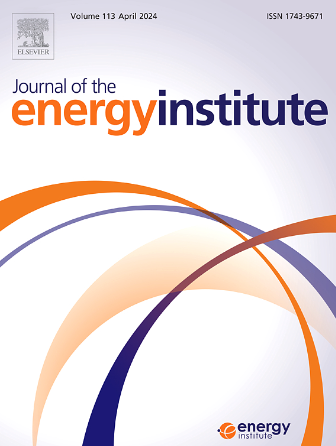Exploring 3-D morphology and mechanical properties for the soot particles produced within a transient diesel reacting jet spray flame under diesel engine-like operating conditions by using atomic force microscopy (AFM)
IF 5.6
2区 工程技术
Q2 ENERGY & FUELS
引用次数: 0
Abstract
In this work, soot particles were directly sampled within a transient reacting jet spray flame under conditions close to practical diesel engine combustion based on the principle of the thermophoretic probe sampling. The experiments were performed in a constant volume combustion chamber (CVCC) with five ambient oxygen concentrations (O2: 21 %, 18 %, 15 %, 12 %, 9 %), accompanied by the subsequent 3-D atomic force microscopy (AFM) imaging to examine not only to what extent the 3-D morphology of the soot particles samples but also their mechanical properties were affected by the variations in the oxygen concentration in the CVCC.
The results showed relatively larger particles were observed in the 3-D AFM images, indicating soot coagulation occurred at the very beginning of combustion process. Three different types of morphology were found for isolated particles samples. The equivalent diameter (ED) of the samples exhibited a broad distribution of about 2–100 nm. When the ambient oxygen concentration was reduced from 12 % to 9 %, similar distribution patterns of ED were found, especially over the range ED < 10 nm. The population-averaged ED decreased firstly and then increased, and was found to decrease again as the oxygen concentration was gradually lowered. The distribution of sphericity ratio for the particles samples fell within the range of 0–0.35, and very low sphericity ratio values (<0.1) were found for most of the isolated particles samples.
Three types of force curves were found for the particles samples. The attractive force fell within the range of 1.4–4.8 nN for all the cases studied. As the ambient oxygen concentration was lowered, the population-averaged attractive force decreased from 2.60 nN to 2.23 nN. The Van der Waals force accounted for over 65 % of the attractive force, and thus played a dominant role in the attractive force. The adhesive force mainly fell within the range of 10–24 nN. As the oxygen concentration was gradually lowered, the population-averaged adhesive force increased from 14.19 to 14.46 nN; the adhesive energy fell within the range of 0–5.1 × 10−16 J, and the population-averaged adhesive energy decreased initially from 1.92 × 10−16 J to 1.79 × 10−16 J, and then increased to 1.89 × 10−16 J. Especially, it was found that the population-averaged adhesive energy was four orders of magnitude higher than the thermal kinetic energy. The Young's modulus fell within the range of 15–520 MPa, while the population-averaged Young's modulus fell within the range of 205–235 MPa, and the population-averaged Young's modulus showed a completely opposite trend to that of the fringe separation distance as the oxygen concentration was lowered.
利用原子力显微镜(AFM)研究柴油机瞬态反应喷射火焰中烟灰颗粒的三维形貌和力学性能
本文基于热电泳探针取样原理,在接近柴油机实际燃烧条件下,在瞬态反应喷射火焰中直接取样烟灰颗粒。实验在五种环境氧浓度(O2: 21%、18%、15%、12%、9%)的恒容燃烧室(CVCC)中进行,并伴随着随后的三维原子力显微镜(AFM)成像,以研究烟灰颗粒样品的三维形貌和力学性能受到CVCC中氧浓度变化的影响程度。结果表明,在三维AFM图像中观察到较大的颗粒,表明煤烟在燃烧过程的一开始就发生了混凝。在分离的颗粒样品中发现了三种不同的形态。样品的等效直径(ED)分布在2 ~ 100 nm之间。当环境氧浓度从12%降低到9%时,发现ED的分布模式相似,特别是在ED <范围内;10纳米。种群平均ED先减小后增大,随着氧浓度的逐渐降低又再次减小。颗粒样品的球度比分布在0-0.35之间,大部分分离颗粒样品的球度比值都很低(<0.1)。在颗粒样品中发现了三种类型的力曲线。在所研究的所有案例中,引力都在1.4-4.8 nN之间。随着环境氧浓度的降低,种群平均引力从2.60 nN下降到2.23 nN。范德华力占引力的65%以上,在引力中起主导作用。黏结力主要在10 ~ 24 nN之间。随着氧浓度的逐渐降低,种群平均粘附力由14.19 nN增加到14.46 nN;黏附能在0 ~ 5.1 × 10−16 J范围内,总体平均黏附能先从1.92 × 10−16 J下降到1.79 × 10−16 J,再上升到1.89 × 10−16 J,黏附能比热动能高4个数量级。杨氏模量在15 ~ 520 MPa范围内,种群平均杨氏模量在205 ~ 235 MPa范围内,种群平均杨氏模量随氧浓度的降低与条纹分离距离的变化趋势完全相反。
本文章由计算机程序翻译,如有差异,请以英文原文为准。
求助全文
约1分钟内获得全文
求助全文
来源期刊

Journal of The Energy Institute
工程技术-能源与燃料
CiteScore
10.60
自引率
5.30%
发文量
166
审稿时长
16 days
期刊介绍:
The Journal of the Energy Institute provides peer reviewed coverage of original high quality research on energy, engineering and technology.The coverage is broad and the main areas of interest include:
Combustion engineering and associated technologies; process heating; power generation; engines and propulsion; emissions and environmental pollution control; clean coal technologies; carbon abatement technologies
Emissions and environmental pollution control; safety and hazards;
Clean coal technologies; carbon abatement technologies, including carbon capture and storage, CCS;
Petroleum engineering and fuel quality, including storage and transport
Alternative energy sources; biomass utilisation and biomass conversion technologies; energy from waste, incineration and recycling
Energy conversion, energy recovery and energy efficiency; space heating, fuel cells, heat pumps and cooling systems
Energy storage
The journal''s coverage reflects changes in energy technology that result from the transition to more efficient energy production and end use together with reduced carbon emission.
 求助内容:
求助内容: 应助结果提醒方式:
应助结果提醒方式:


